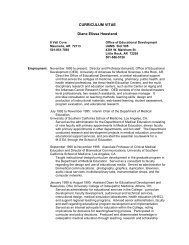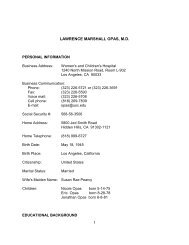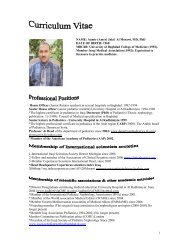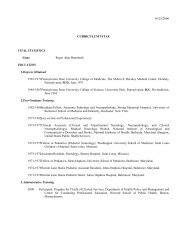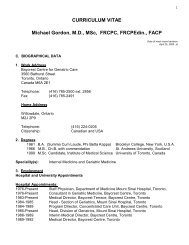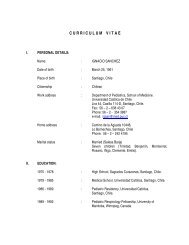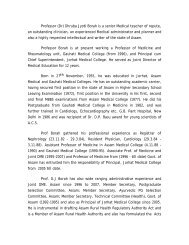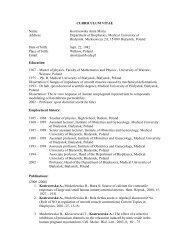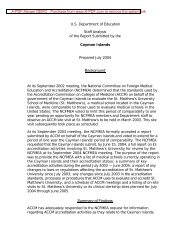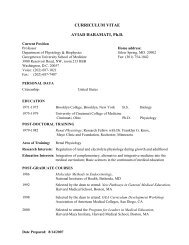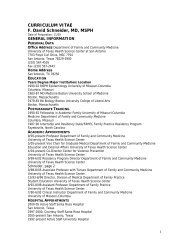St Andrew's report 2008 - General Medical Council
St Andrew's report 2008 - General Medical Council
St Andrew's report 2008 - General Medical Council
You also want an ePaper? Increase the reach of your titles
YUMPU automatically turns print PDFs into web optimized ePapers that Google loves.
Quality Assurance of Basic <strong>Medical</strong> EducationReport on Bute <strong>Medical</strong> SchoolUniversity of <strong>St</strong> AndrewsDecember <strong>2008</strong>
The GMC’s role in medical education1. The Education Committee of the <strong>General</strong> <strong>Medical</strong> <strong>Council</strong> (GMC) sets andmonitors standards in medical education. The standards for undergraduate medicaleducation are set out in the publication Tomorrow’s Doctors.2. In order to ensure that UK medical schools maintain these standards theGMC runs a quality assurance programme, which involves regular assessments andvisits to Schools. This programme is called Quality Assurance of Basic <strong>Medical</strong>Education (QABME) and is carried out on behalf of the GMC Education Committeeby a team of medical and educational professionals, student representatives and laymembers.3. The team make determinations as to whether these Schools are meeting thestandards in Tomorrow’s Doctors after analysing extensive School documentationand completing a range of quality assurance activities at the School and partnerinstitutions. The determinations in this <strong>report</strong> will be endorsed by the GMC EducationCommittee.2
Introduction4. This is the final <strong>report</strong> to the Education Committee of the <strong>General</strong> <strong>Medical</strong><strong>Council</strong> on the quality assurance programme for Bute <strong>Medical</strong> School, University of<strong>St</strong> Andrews (‘the School’) for 2007/08.5. The last GMC review of the School was on 3 May 2006 as part of the QABMEreview of Manchester <strong>Medical</strong> School. A partnership between the two medicalschools allows approximately 80-140 students per year to transfer from <strong>St</strong> Andrewsafter graduating with an Honours BSc in Medicine to Year 3 of the Manchester MBChB course to undertake their clinical training. These students will graduate with aprimary medical qualification from the University of Manchester.6. Although the School does not offer a primary medical qualification it doesprovide a significant number of graduates who complete their clinical training atManchester <strong>Medical</strong> School and will in future go on also to Scottish medical schools.7. The following requirement and recommendations relating to the School weremade during the review of Manchester <strong>Medical</strong> School:a. Manchester <strong>Medical</strong> School must work with <strong>St</strong> Andrews to review theclinical component of the curriculum at <strong>St</strong> Andrews and investigate ways inwhich it could be increased, in order to better prepare students to transfer toYear 3 of the Manchester programme.b. Manchester <strong>Medical</strong> School should hold a joint review of theirprogramme of interactions with <strong>St</strong> Andrews in relation to changes to clinicalexperience in the new curriculum and the continuing links between<strong>St</strong> Andrews and Manchester.c. Manchester <strong>Medical</strong> School should undertake a review of problembased learning (PBL) skills of <strong>St</strong> Andrews students in order for any targetedtraining to take place to ease the transition to the Manchester course.8. The requirement and recommendations were taken into account when settingthe action plan and undertaking this cycle of visits.9. The team are content that the School has successfully addressed therequirement and recommendations from the QABME visit to Manchester <strong>Medical</strong>School in 2006.10. The School introduced a new curriculum in 2004. <strong>St</strong>udents gain direct entry tothe pre-Honours year before completing two further years of Honours level modules.The curriculum is based on the spiral acquisition of knowledge providing afoundation in Year 1, more detailed study of the body systems in Years 2 and 3 andintegration and critical analysis of information gained in Years 2 and 3. <strong>St</strong>udents alsocomplete a research dissertation in Year 3.3
11. There is considerable integration of the clinical component within thecurriculum. Recent graduates interviewed during the visit to Manchester <strong>Medical</strong>School would have welcomed more training in PBL at <strong>St</strong> Andrews. However theirtutors considered there had been a vast improvement and coupled with theadditional induction on PBL at Manchester <strong>Medical</strong> School thought that studentswere adequately prepared.The QABME team12. The visiting team members appointed by the GMC Education Committee toundertake the quality assurance visits were:Professor Julius Weinberg (Team Leader)Professor David Cottrell (Deputy Team Leader)Professor Yvonne CarterProfessor David Croisdale-ApplebyDr Mike GillDr Johann MalawanaMr Matko MarlaisDr Bruno RushforthProfessor Maurice Savage13. Miss Jennifer Barron (GMC Education Quality Officer) and Ms AlisonLightbourne (GMC Education Quality Officer) supported the team.4
Our programme of visits in 2007/0814. The team conducted seven quality assurance visits on: 26 November 2007,28-29 February <strong>2008</strong>, 22 April <strong>2008</strong>, 8 May <strong>2008</strong>, 28-29 May <strong>2008</strong>, 6 June <strong>2008</strong> and3 July <strong>2008</strong>.15. The findings of the team have been reached by reviewing documentaryevidence submitted by the School and undertaking the following activities:a. Meetings with a variety of representatives from the School.b. Site visits to a number of acute and primary care settings.c. Discussions with students.d. Discussions with teachers and tutors.e. Discussions with recent graduates now at Manchester <strong>Medical</strong> School,their teachers and tutors.f. Observation of the Year 3 Objective <strong>St</strong>ructured Clinical Examination(OSCE).g. Observation of Module and Degree Examination Board Meetings.h. Inspection of additional documentation submitted by the School duringvisits and examination papers.5
The <strong>report</strong>Summary of key findings16. The School’s BSc programme meets the outcomes of Tomorrow’s Doctors tothe point of transfer to Manchester <strong>Medical</strong> School in accordance with Section 5(3)of the <strong>Medical</strong> Act 1983.17. We recognise that many of the effective aspects of the programme are theresult of a dedicated group of academics working within a small medical school. Weconsider the supportive atmosphere and ethos to be an integral part of the courseand expect this will be sustained as the medical school expands. We acknowledgethat the School will need a broader number of staff to be engaged to supportcurriculum development, organisation and administration.18. We note the openness of the School to evaluation by others, including fromstudents and from external sources.19. Where there are requirements, the School is requested to respond to therequirements with timelines for action within the 28 day right of reply to the <strong>report</strong>.Requirements20. There are no requirements in the findings of this <strong>report</strong>.Recommendations21. To enhance the quality of the programme we recommend that the School:a. Prioritise the development of clinical placements which should include:i. Opportunities for inter-professional working (see paragraphs 27-28).ii. Implementation of the planned quality management system forplacements as a priority (see paragraph 50).iii. Training of NHS staff (see paragraph 53).iv. Appraisal of both performance and professional attitudes andbehaviours (see paragraphs 74, 86).b. Develop formal, sustainable arrangements for public health teaching sothat public health thinking is embedded in the curriculum (see paragraph 38).6
c. Discuss the following with the University:i. Extending the academic year for <strong>Medical</strong> Science students(see paragraph 42).ii. Reviewing progression rules which mean a student undertakinga re-examination has their grade capped below the standard allowingtransfer to a partner institution, considering the potential to move awayfrom the Honours algorithm where appropriate (see paragraph 87).d. Draw on the experience of transition to Manchester <strong>Medical</strong> School tosystematise formal, structured arrangements with the Scottish Schools.Ensure the availability of formal support for students organising familiarisationvisits to partner institutions (see paragraphs 70-71).e. Review module assessment, particularly where it is competencyrelated, to ensure that the assessment of clinical skills is properly weighted inthe marks affecting progression to a clinical course (see paragraph 83).f. Review the delivery of professional behaviour, careers advice andstudent fitness to practise teaching to:i. Ensure that students are aware of their responsibility to <strong>report</strong>the inappropriate conduct of their colleagues (see paragraph 90).ii. Link careers advice with that delivered at partner institutions(see paragraph 68).Areas of innovation and good practice22. We commend the School on the following areas of innovation and goodpractice:a. The introduction of the yellow card system (see paragraph 24).b. Use of broader educational opportunities within the wider healtheconomy such as placements with funeral directors and NHS 24(see paragraph 25).c. Excellent links with NHS Fife, involvement with and planning within theregion (see paragraphs 40, 46).d. The breadth of dissertation topics (see paragraph 41).e. Development of high quality clinical and communication skills teachingand the strong clinical links developed in anatomy teaching within the degree(see paragraph 55).f. The curriculum tool Galen and its mapping to both Tomorrow’s Doctorsand The Scottish Doctor (see paragraph 58).7
new community hospital within <strong>St</strong> Andrews should also be used to provide increasedopportunity for inter-professional learning.28. Until the longer term initiatives are complete we recommend the Schoolcontinue to explore other opportunities for inter-professional learning, particularlywith other clinical disciplines during clinical placements.29. There is a workshop on team working at the beginning of the course whichintroduces the idea of the doctor as leader. Leadership is also taught through smallgroup work where chairing the group is rotated.Curricular content, structure and deliveryContent30. Curriculum content was originally reviewed in a process lasting from 2002 to2004 when the new curriculum was introduced and mapped against Tomorrow’sDoctors and The Scottish Doctor. The review resulted in new content and forms ofcurriculum delivery, such as guided self study through Galen, which allowed theSchool to retain necessary subject matter and introduce new areas of learning.31. The content of modules is determined by identifying learning objectives and isreviewed regularly by the module controller and the Director of Teaching. Allmodules are reviewed annually by the School Teaching Committee.The scientific basis of practice32. Recent graduates and tutors interviewed in Manchester considered<strong>St</strong> Andrews graduates to have a strong knowledge of basic medical sciences,biomedical sciences, anatomy and physiology.Communication skills33. <strong>St</strong>udents found the structured communication skills teaching to be useful andat the right level to prepare them for their experiences with patients. They felt theyhad sufficient opportunity to practise their skills.34. Although communication skills had been identified as a weakness of the<strong>St</strong> Andrews curriculum in previous GMC <strong>report</strong>s, tutors we met in Manchesterconsidered significant improvements had been made and communications skillswere no longer perceived to be a problem. The most recent cohort of students from<strong>St</strong> Andrews had fed back to Manchester <strong>Medical</strong> School that they did not feel theadditional induction in communication skills at Manchester was necessary and tutorsagreed.9
Teaching skills35. At the time of visiting, students did not teach each other but did undertakepeer reviews of portfolio entries and clinical skills.<strong>General</strong> skills36. The School has placed great emphasis on the teaching of generic skills suchas research, writing skills, presentations and learning to do critical reading in theBMJ style.Disability and rehabilitation37. Currently student exposure to issues of disability and rehabilitation is variable.The School plans to break groups down to smaller numbers in student selectedcomponents (SSC) and community placements next year to increase contact withpatients and provide more learning experiences. We note and support the plans tointroduce a SSC placing students within a school for children with disabilities.The health of the public38. The School should develop formal arrangements for public health teaching.Currently the public health teachers have between 0.25 and 0.5 planned activities forteaching but teaching has to be done in the time allocated for their own continuousprofessional development. We do not think this is an appropriate model and moreformal arrangements should be developed given the need to further embed publichealth thinking in all aspects of the curriculum and because student numbers areexpected to rise.39. The School are planning to integrate public health into the curriculum withmore themes introduced earlier and developed across the three years. Wheresubjects cannot be integrated into the curriculum the School will continue to holdpublic health days to ensure coverage of all essential topics.40. We are encouraged by the recent appointment of a Professor of Public HealthMedicine and think it will make a considerable difference. The School has set up apublic health working group with NHS Fife, which discusses job planning.<strong>St</strong>ructure41. <strong>St</strong>udents are able to explore areas of interest through SSCs which areassessed although not all SSCs contribute towards their Honours classification.SSCs include a critical analysis paper in Year 1, acute/secondary care hospitalmodules in Year 3 and the Year 3 Honours research dissertation. There areadditional poster presentations and ethics <strong>report</strong>s which are student selected10
although the School had not identified them as SSCs. We commend the School forthe wide range of dissertation topics students may choose.42. We encourage the School to discuss extending the academic year for medicalscience students with the University. We think the current 28 week academic year isa challenge to delivering the curriculum and introducing more SSCs. We recognisethe constraint resulting from delivering an Honours degree that has to fit withUniversity regulations and timetable. We acknowledge this would require an increasein staff, funding and resources however with the planned increase in studentnumbers a review of staff, funding and resources will be necessary in the nearfuture.43. The School has completed curriculum mapping exercises with Manchester<strong>Medical</strong> School and plans to engage with the Scottish Schools to benchmark itscurriculum. Considerable progress has already been made through mapping to theScottish Doctor.Delivering the curriculumSupervisory structures44. The School has a relatively small academic management team who providecontinuity through their involvement in the different committees and groups thatmanage the content and delivery of the curriculum.45. Curriculum development is managed by the Teaching Committee andassessment development is managed by the Assessment Committee but alldecisions are referred to the Management Group, which is led by the Head of Schooland is the only executive body in the governance structure. Significant module andassessment changes must also be approved by the University’s Teaching, Learningand Assessment Committee. The Teaching Management Group includes all modulecontrollers, clinical leads and the Director of Teaching, and meets weekly to discussoperational matters associated with delivering the curriculum.46. In developing and managing the curriculum, the School has engaged verysuccessfully with the local Health Board, healthcare providers and the neighbouringDundee <strong>Medical</strong> School.Quality Management47. Quality tools and procedures in use at the School vary from external qualityassurance activities such as the QABME visits to <strong>St</strong> Andrews and Manchester<strong>Medical</strong> Schools and the Scottish Funding <strong>Council</strong>’s Enhancement Led InstitutionalReview to quality management activities such as the use of multiple questionnaires,audit and peer observation of teaching. The School has responded positively toprevious visits and extensively reviewed the curriculum. It is under constant scrutinyand the School Teaching Committee reviews the programme on a yearly basis.11
48. As well as internal scrutiny the School is subject to scrutiny by the University.We are content with the degree of engagement of the University in oversight of theSchool.49. There was effective use of external examiners in reviewing the course andassessment.50. While there is no systematic quality management of placements currently,students provide evaluation of the quality of clinical placements. The communitymedicine lead outlined plans to develop a systematic approach based on visits toplacements and using student evaluation next semester. Implementing the qualitymanagement system for placements should be a priority.51. We found evidence of several ways in which the School monitors the qualityof teaching. <strong>St</strong>udents are invited to evaluate teaching, multiple questionnaires areused, teachers provide peer review and there is faculty discussion. There is a highlevel of student satisfaction with the School’s responsiveness: all students we spoketo believed the School would address reasonable concerns and gave examples suchas the School adjusting the timetable of lectures and long distance placements toimprove the learning experience.52. We are content that the majority of students were satisfied with the level ofsupport provided whilst undertaking the dissertation. <strong>St</strong>udent evaluation indicatedthat learning objectives should be made clearer upon commencement of thedissertation and we note that a decision to introduce a learning agreement for thedissertation was made during the Degree Examination Board Meeting.Teaching and learning53. The School offers training and support for internal and NHS teaching staff inmany ways: through the University Human Resources Department; <strong>St</strong> Andrewslearning and teaching innovation, review and enhancement online initiative; trainingprovided by the School specifically for medical educators; communication skillstraining which uses videos of scenarios and different communications behaviours;and university induction. The School should explore formalising and improvingtraining for clinical teaching staff.54. The staff recruitment policy should take into account the teachingrequirements of the medical school in terms of coping with increased studentnumbers and subject coverage. The profile of suitable teaching staff is a vital part ofmaintaining the achievement of curricular outcomes which will permit the students tomeet the requirements for progression on to the School’s partner institutions.55. The curriculum is delivered through a range of teaching methods. Coresubjects, including science, communication skills and ethics are taught throughlectures, practicals and small group sessions (although these are limited by lack offacilities) then reinforced and developed in clinical or community placements. Wefound an effectively integrated curriculum with good clinical exposure and commendthe depth, quality and clinical relevance of anatomy teaching.12
56. <strong>St</strong>udents experience medicine in a range of different contexts. All studentsparticipate in the Community Medicine Programme: Kirkcaldy and LevenmouthCommunity Attachment programme (KLCAS). The KLCAS comprises tensubstantive half day sessions, with a further ten from August <strong>2008</strong>, taught in acommunity setting outside <strong>St</strong> Andrews. The sessions aim to encourage students tothink about medicine in the context of the community and to understand the role ofother health professionals. Many of these sessions are taught or facilitated byprofessionals from other healthcare disciplines. For example, an occupationaltherapist and a psychiatrist facilitated small group discussion as part of the headinjuries session, which was led by the Director of Fife Rehabilitation Services. Not alltopics afford students the opportunity to work directly with patients or practice clinicaland communication skills. We were pleased to note the Community Lead wasalready identified this and plans to reorganise this teaching for the next academicyear.Learning resources and facilities57. A new purpose built facility is under construction which will prove aconsiderable improvement. Facilities are currently limited and the lack of small groupteaching rooms constrains further curriculum development and increased studentnumbers. <strong>St</strong>udent evaluation suggests the faculty are aware of this and amend theirteaching accordingly. <strong>St</strong>udents praised both the 24 hour computing room and thedissection room.58. We are impressed by the sophisticated yet easy to use online e-portfoliosystem, Galen, and consider it to be a valuable learning resource providing guidanceand learning materials in advance of lectures and classes.<strong>St</strong>udent selection59. Places are oversubscribed and students tend to have excellent academicrecords. The interview is therefore a very important part of the selection process.Interviews are structured and standardised. Applicants are interviewed by a panel oftwo trained interviewers, at least one of which is a medical school staff member. Thesecond member may be from another faculty, honorary teaching staff and NHS staff.There are no student interviewers involved in the application process.60. When deciding which students will progress to which Scottish School, studentchoice at the point of application will be the first criterion, although this is unlikely tomatch the places available across Scotland. Academic attainment at the mid point ofthe second semester of Year 2 will therefore also be used to allocate places, asmodelling has shown this to be a good indicator of honours grades.61. International students must have an International English Language TestingSystem score of 7 or better.62. Applications declaring a disability are referred to the Disabilities Service whocontact the student to ascertain what adjustments would be needed and whether13
these could be provided by the School, seeking advice from occupational health andany other relevant external agencies. This process runs parallel to the selectionprocess and the Director of Admissions will be advised whether reasonableadjustments can be made prior to issuing a conditional or unconditional offer. Wewere provided with information on the role of the Disabilities Service and examplesof how this process had worked.63. The School is committed to widening participation and has an arrangementwith Perth College that up to five students a year who reach a specified standard andachieve a Higher National Diploma in Biomedical Sciences will be accepted directlyinto the medical programme. In addition there is an alternative route for studentsfrom certain schools and non-standard backgrounds to be admitted into a premedicalFoundation year taking first year science subjects from a prescribed list. Ifthe students reach an appropriate level during that science year they may progressto Medicine in their second year. There is additional academic support for thesestudents and staff members have been identified to monitor their progress. Theschool also offers financial assistance. There are currently two students who havebeen selected through this route.<strong>St</strong>udent support, guidance and feedback64. We are impressed by the School’s responsiveness to evaluation and sawmuch evidence of the students’ ability to affect change.65. Each student has a personal tutor whom they must meet at least once a yearand the School offers every student the opportunity to discuss their performance inindividual assessments with a tutor.66. <strong>St</strong>udents we met felt very well supported by the School and the Universitystudent welfare services.67. We encourage the School to further develop opportunities for students toaccess role models while on clinical placements and through the anatomydemonstrators. Role models assist students’ learning about professional behaviourand understanding career development.68. Delivering careers advice is challenging, particularly given the nature of thethree year course. The School should liaise with partner schools and explore themost appropriate ways to introduce students to the career choices available duringtheir time at the School.69. The current system for transfer to the Manchester <strong>Medical</strong> School largelyworks well, though students thought that induction into wider aspects of ManchesterUniversity could be improved.70. The students visit Manchester during the Easter holiday to see the hospitalsand meet other students of Manchester <strong>Medical</strong> School including recent <strong>St</strong> Andrewsgraduates. This trip is organised by students but financed by the School. The team14
ecommend more formal support from the School for the student led organisation ofthis trip.71. The arrangements for transfer to other institutions should be systematised,building on the Manchester experience. The impending transfer of graduates to theother Scottish <strong>Medical</strong> Schools will make the transfer arrangement more complexand the School will have to work with partner institutions to ensure that induction tothe University as well as the <strong>Medical</strong> School is in place.Assessing student performance and competenceThe principles of assessment72. We are content that the School uses a variety of appropriate assessmentmethods: multiple choice questions, short answer questions, Objective <strong>St</strong>ructuredPractical Examinations (OSPEs), OSCE, dissertation, presentation and reflectiveessay. Learning objectives were clearly blueprinted into the assessment system.<strong>St</strong>andard setting and the establishment of cut-points was carried out appropriately.73. There was evidence of appropriate involvement of external examiners. Wesaw written responses to external examiners <strong>report</strong>s and met external examinersduring the Year 3 OSCE and the Module and Degree Examination Board Meetings.Examiners were asked to agree that the cut-points decided by the School wereappropriate and decide on degree classifications for borderline students. The Schoolgave a thorough presentation on their assessment methods and were subject torobust questioning by external examiners. The external examiners praised theSchool but did provide some suggested improvements as detailed below (seeparagraph 85).Assessment procedures74. Feedback given to students on assessment and progression was of highquality; however there was currently little feedback on their performance duringclinical placements. We recommend the School introduce workplace-basedassessments to clinical placements.75. The assessment of basic medical science was appropriate and material wasboth taught and assessed where possible within a clinical context.76. There was appropriate consideration of mitigating factors.77. We agree with the School that as the OSPEs in Years 1 and 2 comprise onlyten stations each, not all of which address clinical and communication skills, it isadvisable not to use marks from these OSPEs to contribute to grade points for themodules they assess. The OSPEs are examinations that students must pass toprogress.15
78. The Year 3 OSCE forms 100% of the assessment for the MD4003 modulewhich contributes 20 credits towards the 240 credits required for the award of anhonours degree. There are 18 stations in the Year 3 OSCE and this assessment isthought to be sufficiently valid and reliable to contribute to the Honours degreeclassification. However, all such assessments must result in a grade point beingawarded which complicates the process. The School would prefer this assessmentto result in a simple pass or fail to reflect the competency based nature of theassessment but this is not possible within the current University assessmentframework. We encourage the School to discuss this matter further with theUniversity.79. Examiners receive a training folder from the School and they have a sessionon the skills that will examine in the OSPE or OSCE. This includes a training sheetdescribing how the School taught the students the particular skill they are examining.The training sheet explains that OSPE/OSCE examiners do not speak except to askdesignated questions.80. The OSCE paperwork we reviewed was clear and we saw evidence duringthe OSCE observation that both students and examiners were well prepared andunderstood the format.81. Training has been provided to the faculty on how to write questions for exams.This was extended to those teaching public health on behalf of the School. TheSchool undertook statistical analysis of questions and removed inappropriatemultiple choice questions and extended matching questions.82. The School has provided clear marking guides for dissertations. All writtenexaminations and dissertations are double marked.83. We recognise the difficulty of <strong>report</strong>ing modules which were for thedetermination of competency or non competency of clinical skills within a frameworkthat required a graded mark that contributed towards an Honours degree.Furthermore we note a concern about the weighting of the OSCE. A student whogained an ordinary in the OSCE but a third overall was discussed during the DegreeExamination Board Meeting and allowed to progress to clinical training. We werepleased that the School will advise Manchester <strong>Medical</strong> School about the student’sperformance. We suggest that the weighting of the OSCE should be reviewed. Wefurther suggest that the <strong>Medical</strong> School and University consider the <strong>report</strong>ing ofmodules as pass or fail where the assessment is competency based to ensure thatstudents are competent before proceeding.84. We heard that the re-introduction of the viva voce at an external examiner’ssuggestion was only for situations where students who had failed a re-examinationand were being asked to leave the course. We do not consider viva voce to be arobust, objective assessment tool and the School could be more robust inchallenging external examiners where there is good evidence to support the School’sprocedures.85. We agreed with the external examiners’ recommendations that students’names should not be used during Module and Degree Examination Board Meetings,16
that dissertation scores should be agreed by more than one person to ensureconsistency, and that a learning contract should be agreed by the student and theirtutor upon commencing the dissertation.Appraisal86. While we were impressed by the feedback given to students during the courseand after examinations, we note that there is currently very little feedback to studentsregarding their performance in clinical placements. <strong>St</strong>udents may receive a prize forthe posters which result from these placements. As the number of placementsincreases the importance of feedback for this part of the curriculum will alsoincrease. The School advised that they would be informed of any students whoperformed poorly on a placement, however, while recognising the placements arenew and in development we consider the School should include placement feedbackmechanisms as a priority.<strong>St</strong>udent progress87. We noted that the practice of capping the marks of students undertaking reexaminationmeant that a student who failed an early exam but later showed aptitudemay nonetheless be prevented from progressing due to their capped mark. Wesuggest that the school discuss this further with the University.88. The School has a process whereby a student can have their specialcircumstances taken into account and ask for a module to be disregarded whenagreeing the final degree classification. <strong>St</strong>udents must, usually, make the Schoolaware of special circumstances in advance of the assessments for the module. Theapplication will be reviewed by the Special Circumstances Board before it is agreed.The School are conscious that support must be offered without offering students theopportunity to choose which assessments will contribute towards their degree.<strong>St</strong>udent health and conduct89. The School use a formal assessment sheet in community medicine to feedback on any fitness to practise issues. The School advised that there have been noserious issues raised and only a few minor concerns regarding the performance ofYear 1 students. The School do not use this system in the acute secondary careplacements as they are still in development and if a student is having problems theSchool will be made aware through informal feedback from clinical supervisors. Werecommend that the School develops a formal mechanism to feedback on studentsin the clinical placements.90. <strong>St</strong>udents were asked to sign a fitness to practise form (Bute <strong>Medical</strong> Schoolagreement) at the beginning of each year. We are not convinced the studentsinterviewed grasped that expectations of medical students differ to those of otherstudents and that their professional responsibility began on day one of medicalschool. <strong>St</strong>udents recognised some aspects of personal professional responsibility,17
however they were not fully aware that certain behaviours might affect their ability toprogress, or of their responsibility towards other students or professional fitness topractice. We suggested that the lack of senior medical students and exposure torecently qualified doctors made “imprinting” attitudes more difficult; this couldpotentially be an additional activity of the anatomy demonstrators.Acknowledgement91. The GMC would like to thank Bute <strong>Medical</strong> School and all those we met withfor their co-operation during the course of the review.18



